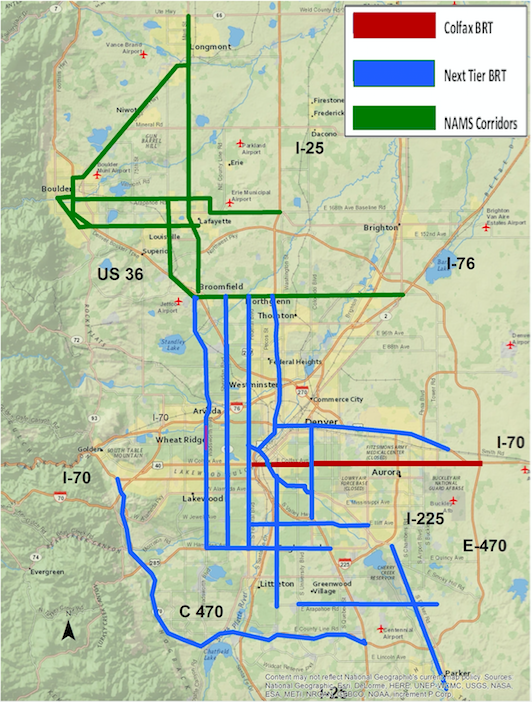If Colorado Doesn’t Spend Smarter on Transport, It’s Going to Choke on Cars

Investing in transit, walking, and biking infrastructure has never been more urgent in Colorado. With the state’s population projected to grow by 2.4 million by 2040, Colorado will choke on its growth unless Governor John Hickenlooper and state and local leaders change course, according to a new report by the Colorado Public Interest Research Group and the Southwestern Energy Efficiency Project [PDF].
“Without significant investments in transit, biking and pedestrian services and infrastructure, Colorado will not be able to meet the demands and challenges of our shifting demographics and growing population, and will miss out on the many benefits transit, walking and biking provide,” the authors state.
Making it faster, safer, and more convenient to get around without driving would also make Coloradans healthier, happier, and more financially stable, the authors write, but the state is failing to allocated the necessary resources.
To properly build out infrastructure like sidewalks, bike lanes, and transitways, Colorado should invest about $1 billion annually for the next 25 years. Some of that money could also fund better transit service to and from ski resorts, making it easier for city dwellers, suburbanites, and tourists to go car-free or car-light.
Colorado’s current system of allocating transportation funds is weighted heavily toward roads at the expense of other modes, said co-author Danny Katz. “Let’s take this seriously — have the same kind of analysis we have for transit, walking, and biking as we do for roads. Have the same flexibility with funding as we do for roads,” Katz said. “Everything should be competing [for funding] on equal footing so we can have a complete transportation system. We did not want it to be an ‘anti-roads’ report. It’s a pro transit, walking, and biking report.”
Here are some of the things Colorado needs to do to bring things up to snuff, and how much the state needs to spend each year, according to the report.
- Launch 14 bus rapid transit lines in metro Denver — $134.6 million annually.
- Build 6,000 miles of new sidewalks and repair 8,600 miles worth of sidewalks in urbanized areas, and maintain the system — $243.6 million annually.

What a future BRT network might look like in and around Denver. Image: SWEEP - Bring every city’s bike network up to the “standard of the state’s best communities” (read: Fort Collins and Boulder) with protected bike lanes, bike-friendly intersections, signage, and parking — $100.8 million annually.
- Grow transit ridership by 100 million trips each year by investing in “fare-free” pass programs like RTD’s EcoPass — $187 million annually.
- Expand bike-share programs to increase access — $11.3 million annually.
- Provide frequent bus service with express lanes between Denver and ski resorts to transport 2.1 million people a year — $135 million in up-front capital costs, $20.2 million in annual operating costs.
- Build regional bike routes that connect cities and towns, and safe highway shoulders for rural riding — $117.4 million.
Improving transit, walking, and biking is not only necessary to manage growth, it’s better for Coloradans physically and financially. Car ownership is generally a household’s second-largest expense, and costs the average American about $8,700 last year, according to AAA. Making it easier for residents to own fewer cars “can help cities remain more affordable and help offset higher housing costs,” the report states.
Redesigning streets for safe walking and biking would also help Colorado chip away at the very solvable public health crisis of traffic deaths and serious injuries. Last year, 488 people were killed in traffic on the state’s streets and highways. The report touches on air quality, too, noting that almost 50 percent of Denver’s ozone-degrading pollutants come from vehicles.
These reasons are well-established. So how will Colorado get another $1 billion each year? It will take a combination of prioritizing sustainable transportation with current money, passing local taxes and fees, and probably raising the federal and state gas taxes — both stagnant for 20 years — according to the report.
Aside from finding new funding streams, policymakers need to rework rules that funnel money into highway and road projects instead of more efficient modes like transit. For example, state law compels Colorado DOT to spend state gas tax revenue and the majority of vehicle registration fees on highways. Lawmakers should also require revenues from toll lanes to fund transit in the same corridor, the report recommends.


